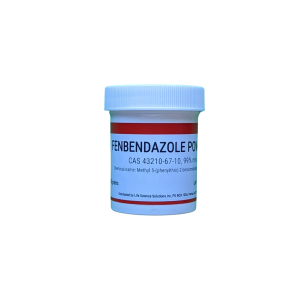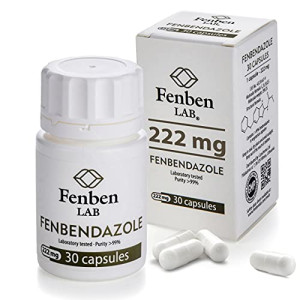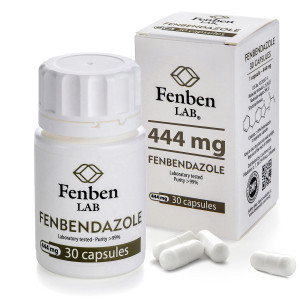-
Sale!

Fenbendazol Powder, Purity >99% 25g/0.9oz
Original price was: $69.90.$52.50Current price is: $52.50. -
Sale!

Fenbendazol Powder, 10g/0.35oz
Original price was: $49.90.$42.75Current price is: $42.75. -
Sale!

Fenbendazol Powder, 120x222mg, 25g/0.9oz
Original price was: $69.90.$52.50Current price is: $52.50. -
Sale!

Fenbendazol 222mg, Purity >99%, 30 caps
Original price was: $65.50.$59.90Current price is: $59.90. -
Sale!

Fenbendazol 222mg, Purity >99%, by Fenben LAB, 30 Caps
Original price was: $61.99.$57.75Current price is: $57.75. -
Sale!

Fenben LAB Fenbendazol 444mg, Purity >99%, 30 Caps
Original price was: $71.99.$69.90Current price is: $69.90.
Fenbendazole
CAS No. 43210-67-9.
EC No. 256-145-7.
Chemical formula: C15H13N3O2S.
This product is not approved by the FDA to diagnose, treat any human disease.
There is no evidence that it can cure or improve any health condition.
The only known and approved application of this product: dewormer for farm and household animals
Fenbendazole (Fenbendazol) is a broad-spectrum benzimidazole anthelmintic used against gastrointestinal parasites including giardia, roundworms, hookworms, whipworms, the tapeworm genus Taenia (but not effective against Dipylidium caninum, a common dog tapeworm), pinworms, aelurostrongylus, paragonimiasis, strongyles, and strongyloides that can be administered to sheep, cattle, horses, fish, dogs, cats, rabbits, most reptiles, freshwater shrimp tanks as planaria and hydra treatments, as well as seals.
Fenbendazole has a broad-spectrum of activity against gastrointestinal roundworms and lungworms of livestock, including adults and L4-larvae of the most important species (e.g. of the genus Bunostomum, Haemonchus, Ostertagia – Teladorsagia, Trichostrongylus, Cooperia, Nematodirus, Chabertia, Oesophagostomum, Trichuris, Dictyocaulus, Muellerius, etc.) as well as arrested larvae of several species. It is also effective against most livestock tapeworms (e.g. Moniezia, Taenia).
In horses it controls the major parasitic roundworms such as Large Strongyles (Cyathostomins), Small Strongyles (Strongylus spp), Parascaris equorum, etc. as well as tapeworms. (e.g. Anaplocephala spp).
It is also effective against the major parasitic roundworms (e.g. Ancylostoma, Toxocara, Trichuris, Uncinaria) and tapeworms (e.g. Echinococcus, Dipylidium, Taenia, etc.) of dogs and cats.
Fenbendazole is absorbed slowly in the stomach. Therefore the longer it remains there, the better the efficacy. In carnivores (e.g. dogs and cats) and other animals with a simple stomach the passage through the stomach is rather fast and therefore a higher dosage is required. This is why it is more often used on livestock than on dogs and cats.
In ruminants, unless delivered using a slow-release device, fenbendazole has only a limited residual effect. This means that a single administration will kill the parasites present in the host at the time of treatment and protect against re-infestations for a few more days, but not for weeks or months. In non-ruminants, the residual effect is substantially shorter, i.e. only a few hours.
At the therapeutic dose, fenbendazole is not effective against flukes and whatsoever external parasites.
Unfortunately, the resistance of several gastrointestinal roundworms to all benzimidazoles,, including fenbendazole is already very high and very frequent worldwide in sheep and goats, slightly lower in cattle. For this reason, the risk that benzimidazoles fail to protect ruminants against gastrointestinal roundworms is considerable worldwide. Resistance of worms to benzimidazoles in dogs, cats, pig and poultry are so far not a serious problem.
Fenbendazole is very poorly soluble in water. Orally administered fenbendazole is poorly absorbed into the bloodstream. Therefore it is very important that it remains as long as possible in the rumen, to form a reservoir from which it is progressively solved and absorbed. Direct administration into the abomasum (e.g. due to the “oesophageal groove reflex”) strongly diminishes the absorption and consequently its efficacy.
Absorbed fenbendazole is metabolized in the liver to its sulfoxide derivative, which is identical with oxfendazole, another veterinary anthelmintic benzimidazole. Interestingly, the oxfendazole produced through metabolism is released back to the rumen, where the bacterial flora reduces it back to fenbendazole. This increases the bioavailability of fenbendazole in ruminants.
Excretion occurs mainly through feces. In cattle and sheep, 6 days after oral administration about 35% of the ingested dose is excreted unchanged, and about 5% metabolized. A small amount is excreted through urine, mainly in the form of various metabolites. Excretion in goats is about twice as fast as in sheep.
In dogs, cats and birds, the absence of such a reservoir as in ruminants strongly shortens the residual effect, which may require a higher dose or more frequent treatments to achieve the desired efficacy. In dogs, 48 hours after administration fenbendazole is not detectable in blood plasma, in birds 36 hours, and in cats 7 days.
The molecular mode of action of all benzimidazoles, including fenbendazole, consists in binding to tubulin, a structural protein of microtubules. These microtubules are important organelles involved in the motility, division, and secretion processes of cells in all living organisms. In the worms the blocking of microtubules perturbs the uptake of glucose, which eventually empties the glycogen reserves. This blocks the whole energy management mechanism of the worms that are paralyzed and die or are expelled.
Since cell division is also disturbed, worm egg production and development is also blocked by benzimidazoles, i.e. most of them also have an ovicidal effect.
